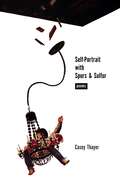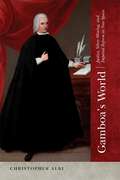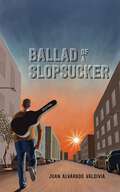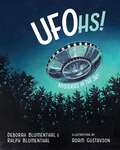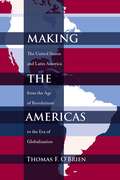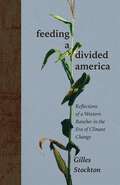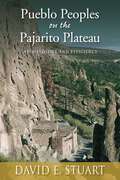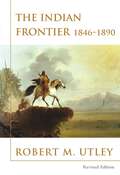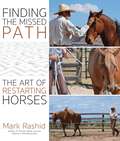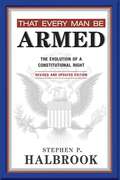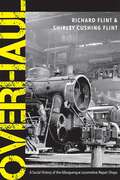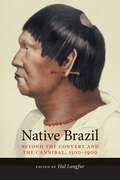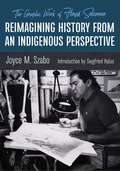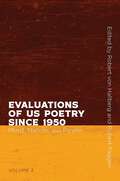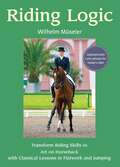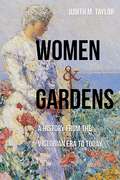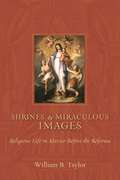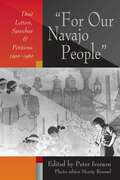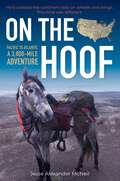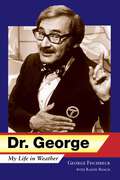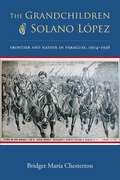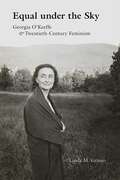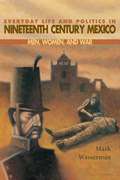- Table View
- List View
Self-Portrait with Spurs and Sulfur: Poems (Mary Burritt Christiansen Poetry Series)
by Casey ThayerPart fun-house hall of mirrors in its distorted and dizzying central narrative, part spaghetti western, and part prayer, Self-Portrait with Spurs and Sulfur is an exploration into the possibilities of storytelling. Through persona poems and odes, the collection argues that the muddier the narrative, the closer the story gets to truth.
Gamboa's World: Justice, Silver Mining, and Imperial Reform in New Spain (Diálogos Series)
by Christopher AlbiGamboa&’s World examines the changing legal landscape of eighteenth-century Mexico through the lens of the jurist Francisco Xavier de Gamboa (1717–1794). Gamboa was both a representative of legal professionals in the Spanish world and a central protagonist in major legal controversies in Mexico. Of Basque descent, Gamboa rose from an impoverished childhood in Guadalajara to the top of the judicial hierarchy in New Spain. He practiced law in Mexico City in the 1740s, represented Mexican merchants in Madrid in the late 1750s, published an authoritative commentary on mining law in 1761, and served for three decades as an Audiencia magistrate. In 1788 he became the first locally born regent, or chief justice, of the High Court of New Spain. In this important work, Christopher Albi shows how Gamboa&’s forgotten career path illuminates the evolution of colonial legal culture and how his arguments about law and justice remain relevant today as Mexico debates how to strengthen the rule of law.
Ballad of a Slopsucker: Stories
by Juan Alvarado ValdiviaA young widower visits Chichén Itzá to honor his wife; family dynamics unravel at a child&’s birthday party; the lead singer of a high school metal band faces his dreaded tenth reunion; a serial killer believes he&’s been blessed by God to murder bicycle thieves—Alvarado Valdivia&’s debut collection of short stories ranges from dark to light and is written with a storyteller&’s skill and compassion. Based in Northern California and examining a variety of themes, including love, family, and masculinity, these stories offer an important new perspective on the experiences of Latinos and Latinas in the United States and complicate ideas of nationhood, identity, and the definition of home.
UFOhs!: Mysteries in the Sky (Barbara Guth Worlds of Wonder Science Series for Young Readers)
by Deborah Blumenthal Blumenthal RalphUFOhs! Mysteries in the Sky is the first book to explore the strange, exciting, and unknown world of unidentified aerial phenomena for kids. UFOhs! cuts through speculation and pseudo-science to describe real phenomena as observed and documented by pilots, ship captains, scientists, and ordinary men, women, and children from around the world. Playful, probing, and beautifully illustrated, UFOhs! Mysteries in the Sky prompts kids and their parents to talk about the moon, the stars, the planets, and all the things they see in the sky, and to wonder about those we can&’t yet explain.
Making the Americas: The United States and Latin America from the Age of Revolutions to the Era of Globalization (Diálogos Series)
by Thomas F. O'BrienAmericans' belief in their economic, political, and cultural superiority launched them on a mission to transform Latin America that has evolved into a global process of Americanization. From corporate and philanthropic initiatives to military interventions, Americans motivated by self-interest and idealism sought to reshape Latin America and gave birth to the American driven process of globalization. Synthesizing a broad range of international relations scholarship, including perspectives from gender, race, and cultural studies, O'Brien offers a sweeping history of the Americas that ranges from the adventures of eighteenth-century whaling men to the contemporary struggle over globalization. As a part of this study, the author explains how the responses of Latin Americans to Americanization have varied from the vehement rejection of U.S. economic dominance to embracing as well as reconfiguring the icons of American consumer culture. O'Brien's goal is to provide readers with a nuanced understanding of how the people of the Americas have shaped their own history, and influenced the development of U.S. economic, strategic, and cultural power in the world today.
Feeding a Divided America: Reflections of a Western Rancher in the Era of Climate Change (New Century Gardens and Landscapes of the American Southwest)
by Gilles StocktonIn Feeding a Divided America, third-generation Montana rancher and international agriculture development specialist Gilles Stockton explores the causes of what he refers to as the “rural-urban divide” and how this widening chasm between rural America and urban centers threatens our democracy. Indeed, it determines the structure of our society, including the physical and political landscapes in which we live. Stockton shows how big banks, international food conglomerates, urban expectations, and US farm policy have all furthered the demise of small towns across America.These essays provide a clear portrait of national food issues surrounding market competition, US trade policy, wildlife controversies, climate change, supply-chain disruptions, and US farm policy, topics that transcend all geopolitical boundaries. Stockton stands firm with American farmers and ranchers, offering potential remedies to these issues in the face of concerns over livelihood, the future of American food systems, and the future of our planet. Stockton’s essays are timely, and they challenge American urbanites and rural folk alike to find ways for all of us to coexist in a changing environment. Whether we eat may depend on it.
Pueblo Peoples on the Pajarito Plateau: Archaeology and Efficiency
by David E. StuartThis lively overview of the archaeology of northern New Mexico's Pajarito Plateau argues that Bandelier National Monument and the Pajarito Plateau became the Southwest's most densely populated and important upland ecological preserve when the great regional society centered on Chaco Canyon collapsed in the twelfth century. Some of Chaco's survivors moved southeast to the then thinly populated Pajarito Plateau, where they were able to survive by fundamentally refashioning their society. David E. Stuart, an anthropologist/archaeologist known for his stimulating overviews of prehistoric settlement and subsistence data, argues here that this re-creation of ancestral Puebloan society required a fundamental rebalancing of the Chacoan model. Where Chaco was based on growth, grandeur, and stratification, the socioeconomic structure of Bandelier was characterized by efficiency, moderation, and practicality.Although Stuart's focus is on the archaeology of Bandelier and the surrounding area, his attention to events that predate those sites by several centuries and at substantial distances from the modern monument is instructive. Beginning with Paleo-Indian hunter-gatherers and ending with the large villages and great craftsmen of the mid-sixteenth century, Stuart presents Bandelier as a society that, in crisis, relearned from its pre-Chacoan predecessors how to survive through creative efficiencies. Illustrated with previously unpublished maps supported by the most recent survey data, this book is indispensable for anyone interested in southwestern archaeology.
The Indian Frontier 1846-1890 (Histories of the American Frontier Series)
by Robert M. UtleyFirst published in 1984, Robert Utley's The Indian Frontier of the American West, 1846-1890, is considered a classic for both students and scholars. For this revision, Utley includes scholarship and research that has become available in recent years.What they said about the first edition:[The Indian Frontier of the American West, 1846-1890] provides an excellent synthesis of Indian-white relations in the trans-Mississippi West during the last half-century of the frontier period. - Journal of American HistoryThe Indian Frontier of the American West combines good writing, solid research, and penetrating interpretations. The result is a fresh and welcome study that departs from the soldier-chases-Indian approach that is all too typical of other books on the topic. - Minnesota History[Robert M. Utley] has carefully eschewed sensationalism and glib oversimplification in favor of critical appraisal, and his firm command of some of the best published research of others provides a solid foundation for his basic argument that Indian hostility in the half century following the Mexican War was directed less at the white man per se than at the hated reservation system itself. - Pacific Historical ReviewChoice Magazine Outstanding Selection
Finding the Missed Path
by Mark RashidHorses are a lot like people, says renowned horseman Mark Rashid. When there are gaps in understanding, confusion, and thus frustration, worry, and even anger are sure to follow.Horses often grow up with these gaps in their training and education. When this happens, it can be difficult for the horse to be a willing partner to a human, and he may need to be restarted—that is, given a second chance to learn what is expected of him and how he can find a place where he is confident and comfortable both beside a handler and beneath a rider.In order to restart a horse successfully, we need to know how to retrace the steps the horse's education has taken and find the path missed the first time around. In this book, the first of the expansive library of books penned by Rashid to include full-color photographs, readers are guided through practical steps for restarting horses, using Rashid's simple yet impactful concepts derived from years of study of martial arts. We walk along with him as he proceeds with the quiet sorting of experience that provides the insight we need to give any horse the new beginning he deserves.
That Every Man Be Armed: The Evolution of a Constitutional Right. Revised and Updated Edition.
by Stephen P. HalbrookThat Every Man Be Armed, the first scholarly book on the Second Amendment to the U.S. Constitution, has played a significant role in constitutional debate and litigation since it was first published in 1984. Halbrook traces the right to bear arms from ancient Greece and Rome to the English republicans, then to the American Revolution and Constitution, through the Reconstruction period extending the right to African Americans, and onward to today&’s controversies. With reviews of recent literature and court decisions, this new edition ensures that Halbrook&’s study remains the most comprehensive general work on the right to keep and bear arms.
Overhaul: A Social History of the Albuquerque Locomotive Repair Shops
by Richard Flint Shirley Cushing FlintIn Overhaul, historians Richard Flint and Shirley Cushing Flint present the largely forgotten story of Albuquerque&’s locomotive repair shops, which were the driving force behind the city&’s economy for more than seventy years. In the course of their study they also document the thousands of skilled workers who kept the locomotives in operation, many of whom were part of the growing Hispano and Native American middle class. Their critical work kept the Atchison, Topeka, and Santa Fe&’s steam trains running and established and maintained Albuquerque&’s unique character in the region.Including a generous selection of historic photographs, Overhaul provides a glimpse into the people, places, culture, and special history found in Albuquerque&’s locomotive shops during the boom of steam railroading. The Flints provide an engaging and informative account of how these shops and workers played a crucial role in the formation and development of the Duke City.
Native Brazil: Beyond the Convert and the Cannibal, 1500-1900 (Diálogos Series)
by Hal LangfurThe earliest European accounts of Brazil&’s indigenous inhabitants focused on the natives&’ startling appearance and conduct—especially their nakedness and cannibalistic rituals—and on the process of converting them to clothed, docile Christian vassals. This volume contributes to the unfinished task of moving beyond such polarities and dispelling the stereotypes they fostered, which have impeded scholars&’ ability to make sense of Brazil&’s rich indigenous past. This volume is a significant contribution to understanding the ways Brazil&’s native peoples shaped their own histories. Incorporating the tools of anthropology, geography, cultural studies, and literary analysis, alongside those of history, the contributors revisit old sources and uncover new ones. They examine the Indians&’ first encounters with Portuguese explorers and missionaries and pursue the consequences through four centuries. Some of the peoples they investigate were ultimately defeated and displaced by the implacable advance of settlement. Many individuals died from epidemics, frontier massacres, and forced labor. Hundreds of groups eventually disappeared as distinct entities. Yet many others found ways to prolong their independent existence or to enter colonial and later national society, making constrained but pivotal choices along the way.
The Bare-toed Vaquero: Life in Baja California's Desert Mountains
by Peter J. MarchandRarely visited by outsiders, the ranchers of the Sierra de la Giganta in Baja California Sur live much as their ancestors have for the past two centuries. They raise goats and cattle and grow a magnificent variety of fruits, vegetables, and flowers. In this book a gifted photojournalist introduces us to individual ranchers and their families and describes their traditional practices and the ways they have adapted to twenty-first-century challenges and technological advances. Marchand&’s photographs and text are both informative and intimate. His introduction to this little-known corner of Mexico will delight travelers and scholars alike.
Reimagining History from an Indigenous Perspective: The Graphic Work of Floyd Solomon
by Joyce M. SzaboFew contemporary artists before the 1990s explored the negative impact of the Spanish in the Southwest, but unreflective celebrations of the Columbus Quincentennial brought about portrayals of a more complicated legacy of Columbus&’s arrival in the Americas—especially by Indigenous artists. Through a series of etchings, Floyd Solomon of Laguna and Zuni heritage undertook a visual recounting of Pueblo history using Indigenous knowledge positioned to reimagine a history that is known largely from non-Native records. While Solomon originally envisioned more than forty etchings, he ultimately completed just twenty. From nightmarish visions of the Spanish that preceded their arrival to the subsequent return of the Spanish and their continuing effects on the Pueblo people, Solomon provides a powerful visual record. These insightful, probing etchings are included in this important full-color volume showcasing Solomon&’s work and legacy. In Reimagining History from an Indigenous Perspective, Joyce M. Szabo positions Solomon among his contemporaries, making this vibrant artist and his remarkable vision broadly available to audiences both familiar with his work and those seeing it for the first time.
Evaluations of US Poetry since 1950, Volume 2: Mind, Nation, and Power (Recencies Series: Research and Recovery in Twentieth-Century American Poetics)
by Robert von Hallberg and Robert FaggenHorace speaks of poetry delighting and instructing. While Evaluations of US Poetry since 1950, Volume 1 explores the pleasures of poetry—its language, forms, and musicality—volume 2 focuses on the public dimensions. In this volume, von Hallberg and Faggen have gathered a diverse selection of poets to explore questions such as: How does poetry instruct a society with a highly evolved knowledge industry? Do poems bear a relation to the disciplined idioms of learning? What do poets think of as intellectual work? What is the importance of recognizable subject matter? What can honestly be said by poets concerning this nation so hungry for learning and so fixated on its own power? To these questions, the literary critics collected here find some answers in the poetry of Robert Pinsky, Susan Howe, Robert Hass, Anthony Hecht, Adrienne Rich, Sharon Olds, Ed Dorn, and August Kleinzahler.
Capturing the Women's Army Corps: The World War II Photographs of Captain Charlotte T. McGraw
by Francoise Barnes Bonnell Ronald Kevin BullisThe photographs taken by Charlotte T. McGraw, the official Women&’s Army Corps photographer during World War II, offer the single most comprehensive visual record of the approximately 140,000 women who served in the U.S. Army during the war. This collection of 150 of McGraw&’s photos includes pictures made in Africa, in England at the headquarters of the European Theater of Operations, in Asia and the Pacific, and in military hospitals in the United States.Serving from July 1942 to August 1946, Captain McGraw provided more than 73,000 photographs to the War Department Bureau of Public Affairs. Her photographs were published in the New York Times, New York Herald Tribune, and used by the Associated Press and the United Press, as well as in recruiting posters, handouts and informational pamphlets, and in the most popular magazines of the era such as Time, Colliers, Women&’s Home Companion, Parade, Saturday Evening Post, and Mademoiselle.
Riding Logic
by Wilhelm MuselerThis book is on the USDF Instructor Certification Recommended Reading List.Wilhelm Müseler's text on riding and horsemanship is internationally revered, and it has now, for the first time, been completely modernized with color photos of the leading riders of the twenty–first century. An expert horseman, Müseler not only provides a wealth of practical knowledge and experience that will help readers attain and maintain the highest level of riding skill, he also offers the theoretical tools that can transform the experienced rider into the classical equestrian ideal—an artist on horseback.The first section of the book is devoted to perfecting the rider's seat, hands, balance, and use of the back. Müseler explains why the rider, from the very first lesson, must concurrently master the three interdependent aspects of rider training—seat, feeling, and influence—in order to become an equestrian of the highest caliber.Müseler then turns his attention to the schooling of both the green and trained horse on the flat, with work in three training stages beginning with the first backing and ending in self-carriage. He provides lessons for improving suppleness, introductory exercises on the trail and over fences, and corrective work for various behavioral or training problems.
Women and Gardens: A History from the Victorian Era to Today
by Judith M. TaylorJudith M. Taylor&’s Women and Gardens highlights the depth and breadth of women&’s influence on gardens and landscapes in the last two hundred years and reveals many unknown or intentionally ignored facts concerning the roles of women in gardening and their contributions to horticultural science. Over eight chapters that investigate the obstacles and opportunities women have encountered in gardening, this book explores the history of women in horticulture, landscape design, and ornamental plant breeding from the Victorian era to today.
Shrines and Miraculous Images: Religious Life in Mexico Before the Reforma (Religions of the Americas Series)
by William B. TaylorThe vast literature on Our Lady of Guadalupe dominates the study of shrines and religious practices in Mexico. But there is much more to the story of shrines and images in Mexico&’s religious history than Guadalupe and Marian devotion. In this book a distinguished historian brings together his new and recent essays on previously unstudied or reconsidered places, themes, patterns, and episodes in Mexican religious history during the seventeenth, eighteenth, and nineteenth centuries.William Taylor explores the use of local and regional shrines as well as devotion to images of Christ and Mary, including Our Lady of Guadalupe, to get to the heart of the politics and practices of faith in Mexico before the Reforma. Each of these essays touches on methodological and conceptual matters that open out to processes and paradoxes of change and continuity, exposing the symbolic complexity behind the material representations.
For Our Navajo People: Dine Letters, Speeches, and Petitions, 1900-1960
by Peter Iverson Monty RoesselOne hundred documents written by Diné men, women, and children speaking for themselves and on behalf of their communities are collected in this book. Discovered during Iverson's research for Diné: A History of the Navajos, these letters, speeches, and petitions, almost all previously unpublished, provide a uniquely moving portrait of the Diné during an era in which they were fighting to defend their lands and to build the Navajo Nation.Six crucial, overlapping subjects are addressed here: land, community, education, rights, government, and identity. Brief introductions to each chapter and each document provide the necessary context, and historic photographs selected by Monty Roessel (Navajo), an outstanding photographer, supplement the words of the people. Most of the vast literature about American Indians emphasizes the actions and words of non-Indians. Indians become the victims, the people to whom things happen. This volume furnishes a different view of the native past. It shows Navajos making their own history. It demonstrates how the Diné worked to keep their lands, develop their economy, build their communities, educate their young people, affirm their rights, govern themselves, and maintain their heritage while forging a brighter future. Included are the words of such prominent leaders as Chee Dodge, Jacob Morgan, Tom Dodge, Annie Wauneka, Sam Ahkeah, and Paul Jones, and less widely known but significant spokespersons like Howard Gorman, Scott Preston, Roger Davis, and Lilly Neill. It also presents the words of students at boarding schools, soldiers fighting in World War II, and members of the Native American Church speaking out for religious freedom. This book celebrates the resilience of the Diné and salutes their resolve. It honors the men, women, and children who built the Navajo Nation.Monty Roessel (Navajo), Executive Director of the Rough Rock Community School, has written and provided photographs for award-winning books for young people.
On the Hoof
by Jesse Alexander McNeilThe true tale of a voyage that broke a man down and built him back up, with the help of one special horse.At 36 Jesse McNeil—at times carpenter, commercial fisherman, dabbler in real estate—decided to buy an untrained horse, make himself into a horseman, and ride all the way across the United States, from the Pacific to the Atlantic Ocean.A fiercely independent traveler, Jesse had navigated previous coast-to-coast trips—solo journeys by moped, bicycle, and small airplane. This time, however, he had a partner: a five-year-old Tennessee Walking Horse named Pepper. An inexperienced horseman with an equally inexperienced mount, Jesse would quickly discover the immense challenges of his new undertaking. Over the course of eight months and fourteen states—beginning in Oregon and ending on a beach in New Hampshire—he would be tested many times over as he learned not only what it took to keep Pepper safe and healthy, but the true value of qualities that he had once easily dismissed: patience and companionship.The generosity of strangers, from helpful ranchers and storekeepers to suburban families, shaped the pair's journey east. And while at some points the miles didn't unfold as Jesse hoped, others yielded unexpected events that changed his perspective—and quite possibly, his future. Written with honesty, grit, and grace,On the Hoofcaptures an arduous voyage that broke a man down and built him back up, with the help of one special horse.
Dr. George: My Life in Weather
by George Fischbeck Randy RoachFor twenty-three years, George Fischbeck was a schoolteacher in Albuquerque, and for the last thirteen of those years taught science on a public television station that was beamed all over New Mexico. He also served as a weatherman on Albuquerque&’s top-rated TV newscast where he was so popular that the general manager of a competing station sent tapes of his weather forecasts to all the top ABC Network stations nationwide in hope that one would hire George and get him out of New Mexico. When KABC-TV in Los Angeles responded, it was the start of a love affair between Dr. George and the City of Angels that continues to this day. Not only has Fischbeck had a long career as an awardwinning journalist and educator, he has also helped raise millions of dollars for a variety of charitable causes. His story is all here, and the best part is what the fewest people know: the heartwarming memories of a family man.
The Grandchildren of Solano López: Frontier and Nation in Paraguay, 1904–1936
by Bridget María ChestertonParaguay&’s Chaco frontier, one of the least known areas in one of the least known countries in South America, became the unexpected scene of the bloodiest international war in the Americas, the Chaco War between Paraguay and Bolivia (1932–35).A picture postcard from the Chaco War era shows a large heart, emblazoned with the word &“Paraguayo,&” pumping its way through the flat dusty wilderness of the Chaco and leaving a zigzag trail of smashed Bolivian forts and soldiers along the way. This visual propaganda shows why the Paraguayans were sure they would win the war: they were brave, passionate soldiers. They considered themselves invincible descendants of the great hero of the War of the Triple Alliance (1864–70), Marshal Francisco Solano López (El Mariscal).But Solano López was not universally revered. A controversial figure, he was widely believed to have led Paraguay into economic, social, and cultural ruin. The debate over López&’s actions shaped the country&’s culture and politics for over a century after the War of the Triple Alliance. Bridget María Chesterton&’s in-depth examination of Paraguay&’s unique nationalism and the role of the frontier in its formation places the debate over López in the context of larger themes of Latin American history, including racial and ethnic identity, authoritarian regimes, and militarism.
Equal under the Sky: Georgia O'Keeffe and Twentieth-Century Feminism
by Linda M. GrassoEqual under the Sky is the first historical study of Georgia O&’Keeffe&’s complex involvement with, and influence on, US feminism from the 1910s to the 1970s. Utilizing understudied sources such as fan letters, archives of women&’s organizations, transcripts of women&’s radio shows, and programs from women&’s colleges, Linda M. Grasso shows how and why feminism and O&’Keeffe are inextricably connected in popular culture and scholarship. The women&’s movements that impacted the creation and reception of O&’Keeffe&’s art, Grasso argues, explain why she is a national icon who is valued for more than her artistic practice.
Everyday Life and Politics in Nineteenth Century Mexico: Men, Women, and War (Diálogos Series)
by Mark WassermanIn this new and masterful synthesis, Wasserman shows the link between ordinary men and women-preoccupied with the demands of feeding, clothing, and providing shelter-and the elites' desire for a stable political order and an expanding economy. The three key figures of nineteenth-century Mexico-Antonio López de Santa Ana, Benito Juárez, and Porfirio Díaz-are engagingly reinterpreted. But the emphasis in this book is on the struggle of the common people to retain control over their everyday lives. Concerns central to village life were the appointment of police officials, imposition of taxes on Indians, the trustworthiness of local priests, and changes inland ownership. Communities often followed their leaders into one political camp or another-and even into war-out of loyalty. Excesses in partisan politics and regional antagonisms gave rise to nearly eighty years of war, resulting in the nation's economic stagnation between 1821 and 1880 and the mass migration of women from the countryside to the city. The industrialization of urban employment forever altered gender relations. During wartime, women acted as the supply, transportation, and medical corps of the Mexican armies. Moreover, with greater frequency than has been known, women fought as soldiers in the nineteenth century. This account of Mexico from Independence to the Revolution combines lively explanations of social history, political and economic change, and gender relations. Wasserman offers a well-written, thoughtful, and original history of Mexico's nineteenth century that will appeal to students and specialists alike.At long last, a clear-headed, non-romanticized, and non-adversarial analysis of everyday life and politics across the vast sweep of a century of change and rebirth. This is a first-rate book, expert and highly accessible.--Professor Timothy E. Anna, University of Manitoba
